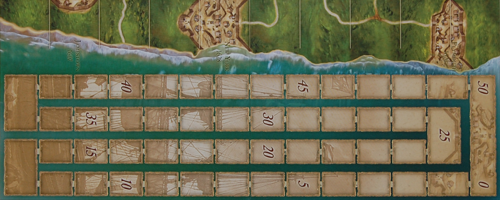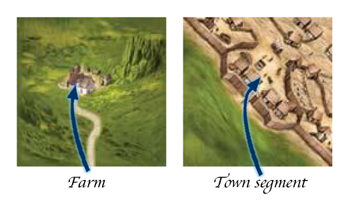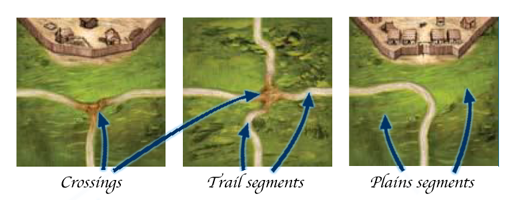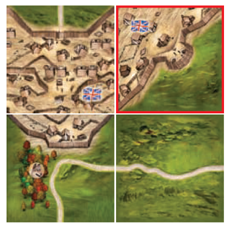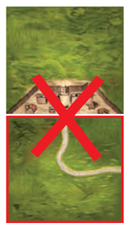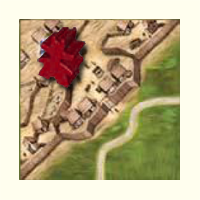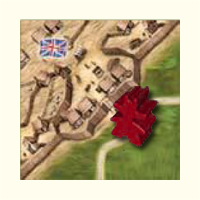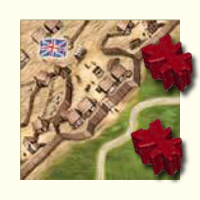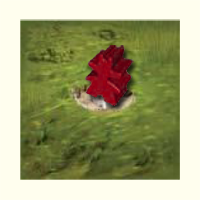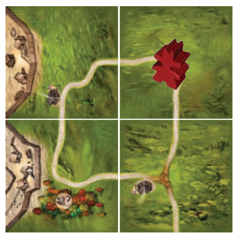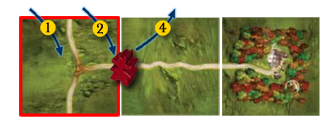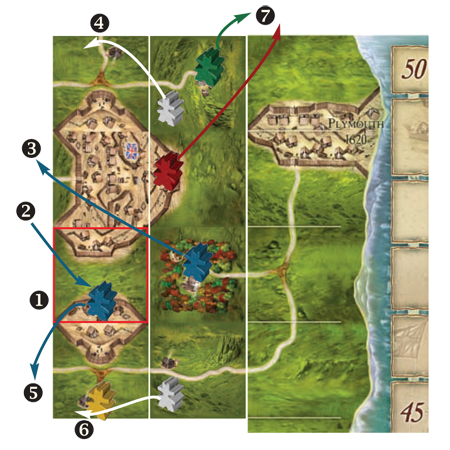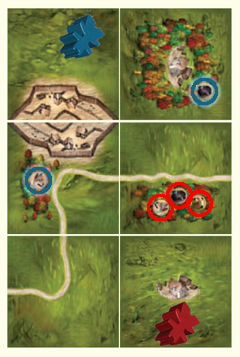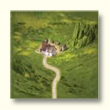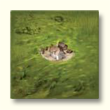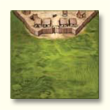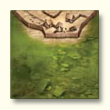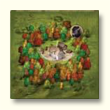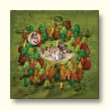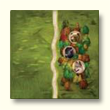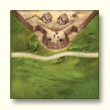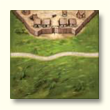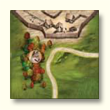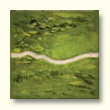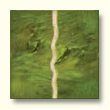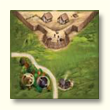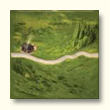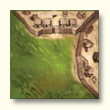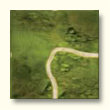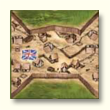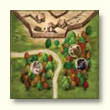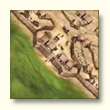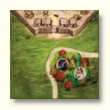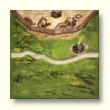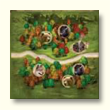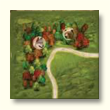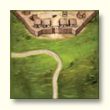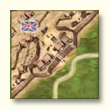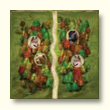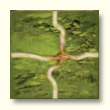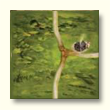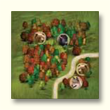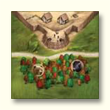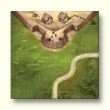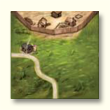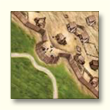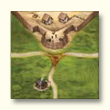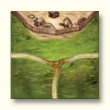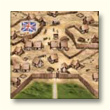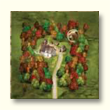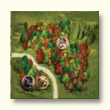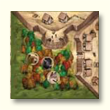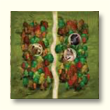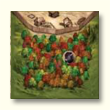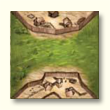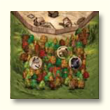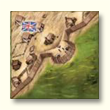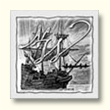Difference between revisions of "New World Base Game/nl"
(Created page with "{{BeginBlockList|700px}} {{Block| frame|none|De weg en de velden worden uitgebreid }} {{Block| frame|none|De stad wordt uitgebreid }} {{EndBlockList}}") |
(Created page with "=== Een kolonist zetten ===") |
||
| Line 127: | Line 127: | ||
De speler die een outlaw op een afgebouwde weg heeft, krijgt '''één punt voor elke tegel''' waaruit de afgebouwde weg bestaat (tel het aantal tegels; afzonderlijke delen op dezelfde tegel tellen maar één keer mee) en '''2 punten voor elke handelspost''' aan die weg. | De speler die een outlaw op een afgebouwde weg heeft, krijgt '''één punt voor elke tegel''' waaruit de afgebouwde weg bestaat (tel het aantal tegels; afzonderlijke delen op dezelfde tegel tellen maar één keer mee) en '''2 punten voor elke handelspost''' aan die weg. | ||
De speler verplaatst zijn scoresteen zoveel plaatsen vooruit op het scorespoor als dat er punten verkregen zijn. Passeer je je de 50 op het scorespoor, leg je scorepion dan plat neer om aan te geven dat je meer dan 50 punten hebt en ga verder op het scorespoor. | |||
<table> | <table> | ||
Revision as of 23:03, 12 September 2022
Hoofdpagina > Mayflower > Mayflower Basisspel
Algemene informatie en opmerkingen
Oorspronkelijk in Template:Year nl uitgebracht door Hans im Glück als Mayflower; toen het in het Engels werd uitgegeven door Rio Grande Games, werd de naam veranderd in New World. De Nederlandse editie handhaaft de naam Mayflower.
Het spel gebruikt veel van de standaard Carcassonne spelconcepten, maar verplaatst het van middeleeuws Frankrijk naar de vroege nederzettingen aan de Noord-Amerikaanse oostkust.
De spelers ontwikkelen de Nieuwe Wereld vanuit een voorstelling van de oostkust tussen Jamestown in het zuiden, dat zich uitstrekt tot Plymouth in het noorden. De kust achter zich latend, steeds verder westwaarts verkennend, zetten de spelers hun kolonisten in op de wegen, dorpen, boerderijen en velden. De vaardigheden van de spelers om het gebied te ontwikkelen en hun kolonisten als sheriff, outlaw, pelsjager of boer in te zetten, zullen bepalen wie de overwinning behaalt.
De spelers leggen om de beurt landtegels aan. Daarmee ontstaan paden, steden, velden en boerderijen die groeien. Tijdens hun beurt kunnen de spelers hun kolonisten inzetten op deze projecten om punten te verdienen. Spelers krijgen zowel tijdens als aan het einde van het spel punten. De speler die na de eindtelling de meeste punten verzameld heeft, is de winnaar.
Het spel introduceert het concept van grootgrondbezitters die de kolonisten westwaarts volgen. Als jouw kolonisten er niet in slagen ten westen van de grootgrondbezitters te blijven, kunnen ze de kans om punten te verdienen kwijtraken.
Speelmateriaal
- 95 landtegels
- 30 kolonisten in 5 verschillende kleuren (6 van elk, waarvan er één als scoresteen wordt gebruikt)
- 2 grootgrondbezitters in het wit
- Speelbord met scorespoor en startposities aan de oostkust
Voorbereiding
Leg het speelbord aan de rand van de tafel zodat de startvelden richting het midden van de tafel wijzen. Schud alle landtegels gedekt en vorm gedekte stapels zodat alle spelers er gemakkelijk bij kunnen. [1]
Iedere speler krijgt de 6 kolonisten in een kleur naar keuze en zet er één als scoresteen rechtsboven op het grote veld "0" van het scorespoor. De overige 5 kolonisten legt elke speler als voorraad voor zich neer op tafel.
Zet één grootgrondbezitter op het bovenste en één op het onderste startveld op het speelbord.
De jongste speler mag zeggen wie er begint.
Spelverloop
Er wordt met de klok mee gespeeld. Wie aan de beurt is voert de hierna genoemde acties in de aangegeven volgorde uit:
- De speler moet een nieuwe landtegel trekken en passend aanleggen
- De speler mag daarna als hij/zij dat wil één van zijn/haar kolonisten uit zijn/haar voorraad op de zojuist aangelegde landtegel leggen
- Als door het aanleggen van de landtegel, wegen, steden of boerderijen afgebouwd worden, worden die direct geteld
- De beurt van de speler is nu voorbij en is de volgende speler aan de beurt
Deze acties worden in de secties hieronder nader beschreven.
Landtegel leggen
Eerst moet een speler een landtegel trekken van één van de gedekte stapels. Deze toont hij aan alle spelers, die hem daardoor kunnen en mogen "adviseren". Daarna legt hij de tegel aan het speelveld, rekening houdend met de volgende spelregels:
- De nieuwe tegel (in de voorbeelden rood omrand) moet met tenminste één zijde aan één of meer eerder gelegde landtegels of aan een startpositie op he speelveld gelegd worden. [2] [3] Men mag géén tegels diagonaal uitsluitend met de hoeken tegen elkaar aanleggen.
- De nieuwe tegel moet zo aangelegd worden dat alle velden, wegen en stadsdelen op de nieuwe tegel alle aangrenzende velden, wegen en stadsdelen voortzetten.
In het zeldzame geval dat een getrokken tegel nergens op een geldige manier kan worden aangelegd (en alle spelers het daarover eens zijn), wordt deze in de doos gelegd en trekt de speler een nieuwe tegel.
Een kolonist zetten
Nadat de speler zijn landtegel heeft aangelegd, mag hij/zij een kolonist inzetten. Daarbij gelden de volgende spelregels:
- De speler mag per beurt slechts 1 kolonist zetten
- De speler moet die uit zijn voorraad nemen
- De speler mag hem alleen op de zojuist aangelegde tegel zetten
- De speler moet kiezen waar hij de kolonist op de tegel wil inzetten: als
- De speler mag geen kolonist zetten op een veld, stad of weg waar al een andere (evt. eigen) kolonist staat. Het speelt daarbij geen rol hoe ver weg de andere kolonist staat. Zie de voorbeelden hieronder.
Als een speler alle kolonisten heeft ingezet, gaat hij/zij verder door elke beurt landtegels aan te leggen. Hoewel kolonisten niet teruggehaald mogen worden, keren ze wel terug wanneer boerderijen, wegen en steden geteld worden.
Nu is de beurt van de speler voorbij en is de volgende speler met de klok mee aan de beurt, enzovoort.
Bedenk: als door het aanleggen van de tegel een weg, stad of boerderij afgebouwd wordt, worden die geteld voordat doorgegaan wordt met de volgende speler.
Puntentelling afhandelen
Een afgebouwde weg
Een weg is afgebouwd als de wegdelen aan beide kanten eindigen bij een splitsing, een stadspoort of een boerderij met een weg, of als de weg een lus vormt. [4] De weg kan vele delen hebben tussen de eindpunten.
De speler die een outlaw op een afgebouwde weg heeft, krijgt één punt voor elke tegel waaruit de afgebouwde weg bestaat (tel het aantal tegels; afzonderlijke delen op dezelfde tegel tellen maar één keer mee) en 2 punten voor elke handelspost aan die weg.
De speler verplaatst zijn scoresteen zoveel plaatsen vooruit op het scorespoor als dat er punten verkregen zijn. Passeer je je de 50 op het scorespoor, leg je scorepion dan plat neer om aan te geven dat je meer dan 50 punten hebt en ga verder op het scorespoor.
A Completed Town
A town is complete when the town is completely surrounded by a town wall and there are no gaps in the wall. [5] A town may have many segments.
The player who has a shopkeeper in a completed town scores two points for each tile in the town (count the tiles, not the segments). Each flag on segments in the town earns the player 2 points.
| When a tile has 2 segments in a town, it still counts for just 2 points (1 tile). |
What if a completed town or trail has more than one settler? It is possible through clever placement of land tiles for there to be more than one robber on a trail or more than one shopkeeper in a town. In a completed trail or town, the player with the most robbers (on a trail) or the most shopkeepers (in a town) earns all the points.
When two or more players tie with the most robbers or shopkeepers, they each earn the total points for the trail or town.
A Completed Farm
A farm is complete when the tile it is on is completely surrounded by land tiles. The player with a farmer in the farm earns 9 points (1 for the farm tile and 1 each for the other tiles).
After Scoring
After a trail, a town, or a farm is scored (and only then), the settlers involved are returned to the appropriate players' supplies. The returned settlers may be used by the players as any of the possible settlers (robber, farmer, shopkeeper, or farmer) in later turns.
It is possible for a player to deploy a settler, score a trail, town, or farm, and have the settler returned on the same turn (always in this order):
- Complete a town, trail, or farm with the new tile
- Deploy a shopkeeper, robber, or farmer
- Score the completed town, trail, or farm
- Return the shopkeeper, robber, or farmer to player's supply
Surveyors: Their Bonuses and the limits they impose
After each feature is scored (there may be more than one in a turn), the player whose turn it is moves one surveyor one column to the west (away from the coast). It doesn't matter which tile the player places the surveyor on as long as it is in the correct column. The player must move the eastern-most surveyor if the surveyors are not in the same column. Thus, the two surveyors will never be more than one column apart in their westward trek. If the surveyors are both in the western-most column of tiles (no tiles to their west) neither moves. They will remain there until a feature is scored and there are tile(s) to their west. If a feature is completed, but not scored, the player does not move a surveyor. If there is only one tile in the westernmost column, both surveyors may share that space.
Scoring Bonus
When a settler is scored that is standing on the same column with one (or two) surveyor(s), the player scoring the settler gets +4 points for each surveyor! (note: a surveyor is moved after the settler is scored!)
Removing fallen-behind settlers
When a surveyor is moved west remove any standing settlers (not trappers - they remain lying down until the end of the game) from any columns to the "east" of the eastern-most surveyor and return them to their owners without scoring. [6] A player may place a settler on a just-placed tile in columns "east" of the surveyors, but it is dangerous as such a settler (not a trapper) will be removed immediately after the next scoring! [7]
The Plains
Connected plains segments are called plains. Plains are not scored if completed during the game. Players may deploy trappers on plains segments, but they only score at the end of the game. A trapper remains in the plains segment where it is deployed for the entire game and is never returned to the player's supply! To emphasize this, place the trapper on its side on the plains segment. Plains are bordered by trails, towns, and the edge of the area where the land tiles are played.
Game End
At the end of the player's turn during which the last land tile is placed, the game ends. If the player completes one or more features, these are scored as normal and then the game proceeds to the final scoring.
Final Scoring : Incomplete Trails, Towns and Farms
For each incomplete trail and town, the player, who has a robber on the trail or shopkeeper in the town, earns one point for each trail or town segment (instead of 2 points). Flags (in towns) are worth 1 point each (instead of 2 points), but Trading Posts (on trails) are still worth 2 points. [8]
For incomplete trails and towns with more than one settler, use the rules for completed trails and towns to determine who scores.
For an incomplete farm, the player with the farmer on the farm earns 1 point for the farm and 1 point for each land tile surrounding it.
Final Scoring : Trappers (for the animals in the plains)
Tip: To make plains scoring easier, remove settlers as you score the unfinished trails, towns, and farms.
In each plains area at the end of the game, the player with the most trappers in the area scores 1 point for each animal shown on plains segments in the area - there is no difference between the animal types. As with trails and towns, if several players tie with the most trappers in the area, each scores 1 point for each animal shown on the plains segments in the area.
When all completed plains areas are scored in this way, the scoring and the game is over.
The player with the most points is the winner. If players tie with the most, they rejoice in their shared victory.
Tile distribution
Tile Count: 95
Back of Tiles:
House Rules
Place one surveyor on the start board, and the other on the 0 space of the scoring track. When the first trail, town or farm is completed, move the surveyor from the 0 space to the 1 space on the scoring track. Repeat from 1 to 2, 2 to 3, until he reaches space number 5, at which point he is placed on the game board, in any of the starting spaces (as described under preparation, above. Thereafter, the surveyors move, as described, when features are scored. (from BGG)
Credits
This page is primarily based on the New World rules published by Rio Grande Games with minor revisions to both rules and images adapted from the original Hans im Glück Mayflower rules where there has been some variation between sources. Additional comments and clarifications have come from various Carcassonne discussion forums (BGG, CarcC and CarcF).
Voetnoten
Kijk op de Pictogrammen pagina voor uitleg over en licensering van de pictogrammen.
- ↑
 Je kunt ook een kleine zak gebruiken als je die hebt.
Je kunt ook een kleine zak gebruiken als je die hebt.
- ↑ Als de tegel aan het speelbord wordt gelegd, moet dat ten westen van de tien startposities gebeuren en niet tegen de noordelijke of zuidelijke grens.
- ↑
 Later aangelegde tegels mogen ten noorden of ten zuiden van het speelveld aangelegd worden, maar alleen aan reeds gelegde tegels, niet aan het speelbord zelf. Als het landschap zich ten noorden of ten zuiden van het speelbord uitstrekt en er zich tegels in de eerste kolom van het landschap bevinden, mogen latere tegels niet verder naar het oosten (terug richting de zee) aangelegd worden.
Later aangelegde tegels mogen ten noorden of ten zuiden van het speelveld aangelegd worden, maar alleen aan reeds gelegde tegels, niet aan het speelbord zelf. Als het landschap zich ten noorden of ten zuiden van het speelbord uitstrekt en er zich tegels in de eerste kolom van het landschap bevinden, mogen latere tegels niet verder naar het oosten (terug richting de zee) aangelegd worden.
- ↑
 Een reactie van HiG impliceert dat ook de "tegelvakken" op het speelbord meetellen voor de puntentelling, dat geldt dus voor de weg die op het speelbord bij de zee eindigt.
Een reactie van HiG impliceert dat ook de "tegelvakken" op het speelbord meetellen voor de puntentelling, dat geldt dus voor de weg die op het speelbord bij de zee eindigt.
- ↑
 By implication in a response from HiG that the "tile spaces" on the starting board are to be included for scoring purposes, this thus includes the coastal towns of New York and Jamestown.
By implication in a response from HiG that the "tile spaces" on the starting board are to be included for scoring purposes, this thus includes the coastal towns of New York and Jamestown.
- ↑ The RGG rules stated "Whenever the eastern-most surveyor is moved west ..." but this has been clarified as unclear on BGG although it could be argued that if both surveyors are in the same column they could both be considered "easternmost", and if in different columns, then the easternmost one must be moved. Therefore it implies it is each time!
- ↑ There is nothing to stop a player placing a tile to complete a feature east of the surveyors, placing a settler on it and immediately scoring, as the surveyor moves after the scoring has taken place and the settler returned to the player's supply.
- ↑ Although not specified in the main RGG rule, Trading Posts are listed in the Scoring Summary at the foot of the last page.


